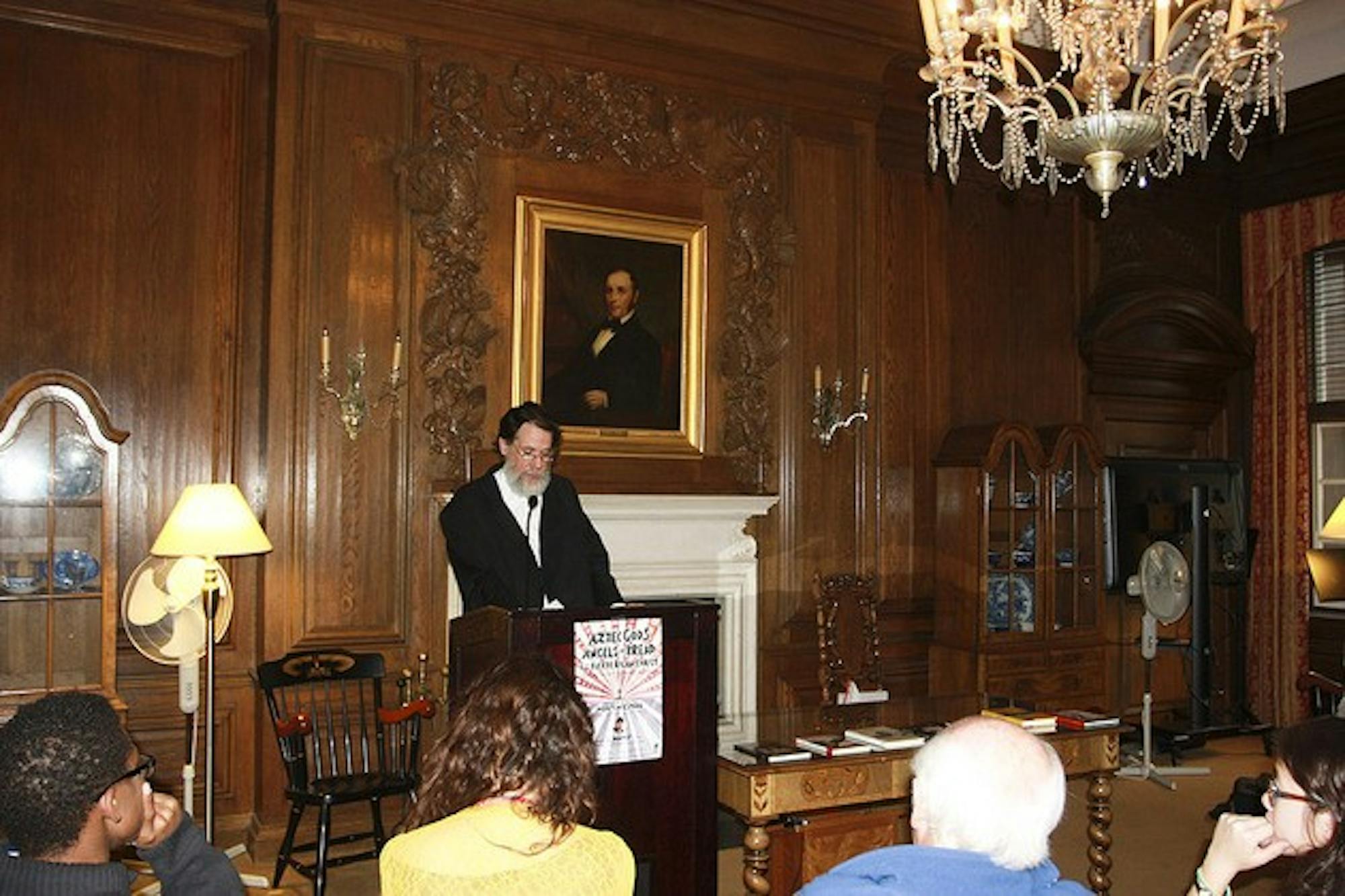The reading marked the first time that Espada talked publicly about the religious symbolism in his work, according to religion professor Elizabeth Perez. Perez was a former student of Espada's at the University of Massachusetts, Amherst and organized his visit to campus.
Perez introduced Espada, a Pulitzer Prize finalist in literature, as "one of the most accomplished poets working in the modern vernacular."
"Even today, 20 years later, I am still amazed by how much this man has influenced my thinking and my scholarship," she said. "He is one of the finest living writers in the United States."
Espada began his reading with the disclaimer that although he himself is a nonbeliever, he credits religion with being "essential" to his work.
"I was raised by a Puerto Rican father and Jewish Jehovah's Witness mother," Espada said. "My dad was a ship clerk and a skeptical Catholic. Ultimately, his agnostic and evolutionary views won out with me."
Religious symbolism and the vernacular are common inspirations for any poet regardless of his or her personal beliefs, according to Espada. Poets like Espada, who work to promote social justice through their poetry, may particularly use this type of symbolism, he said.
"Religion provides the vocabulary, motifs and visual images for a poet," Espada said. "It carries in it the same vision for progressive social change."
Throughout Espada's career, he has worked primarily as a poet, but he has also spent time as an editor, essayist and translator. He has published 17 books, including his most recent publication "The Trouble Ball," which was released this spring and was available for signing at Sanborn yesterday. Espada currently works as an English professor at the University of Massachusetts, Amherst.
The eight poems that Espada chose to read were replete with religious imagery of saints, prophecies and the crucifixion, but his focus was largely on the individuals in the scenes. His religious references never dwarfed the interactions between families, friends or countrymen, but rather served as a sort of reference point or structure to draw in his readers.
Many of Espada's poems also referenced the culture of Puerto Rico, an island to which the poet travels often to visit family and friends. One such poem, "En La Calle San Sebastian," described how the Spanish brought the Yoruba people from Africa to the island to work as slaves, cultivating sugar cane. The poem focused on the Yoruban defiance of Spanish orders to cease playing their traditional music, which was an early precursor of modern Salsa. The poem blended Catholic imagery with a tempo that beat like drums and dancers' feet, culminating in a feverish crescendo that repeated the poem's title.
Esapada also read excerpts from his prose pieces, including personal bits about his family and early upbringing. While these readings were descriptive and laced with poignant imagery, his work was notably humorous, especially in its most personal moments that discussed his childhood. In the poem "The Playboy Calendar and the Rubaiyat of Omar Khayyam," Esapada compares his reaction to two gifts he received from his father after graduating from high school: a Playboy calendar with a buxom blonde on the cover and a translation of selected poetry by an ancient Persian poet. Ironically, Espada chose to hide the poetry within the calendar to prevent any intruders from reading the provocative material.
A number of Espada's poems were infused with episodes from his own life, ranging from funerals of relatives to interactions with penitentiary inmates, which were all vividly described. This gave scenes not only literal importance in the poems but also monumentalized them. In "The Poet in the Box," Espada described a juvenile inmate's solitary confinement as a magical place where he was able to write poetry, a place where "poetry was a grasshopper in the bowl of his hands" and "the script of a pharaoh's deeds on pyramid walls."
Espada said his goal is for poets to serve as visionaries to bring about positive social change. In his own poetry, he tries to promote society as being able to gradually achieve utopian ideals, describing it as working to eradicate ills like hunger and poverty.
"Poets are visionary," Espada said. "They say what is un-sayable in a society and can envision what is impossible at the present but can in the future come to pass."
Espada cited the role that intellectuals played to unite citizens of Latin American countries against colonialism and imperialism as a historical example of this concept. Poets who were also political activists, such as Cuba's Jose Marti, Nicaragua's Ruben Dario and Chile's Pablo Neruda, have all served as role models for Espada, he said.
"Poets can perform various functions," he said. "They can be a historian when elements of history remain hidden, a journalist when the truth is not being told or a community organizer when organizing is what we need."
In the poetry he read, Espada commented most pointedly on social issues in "Crucificixion in the Plaza de Armas," about a black man's protest against racism, and in "Imagine the Angels of Bread," about a year when justice is brought to the world to reward the hungry and meek.
Espada has been the recipient of a number of awards and distinctions throughout his career, including the American Book Award, the National Hispanic Cultural Center Literary Award, a Guggenheim Foundation fellowship and a Paterson Award for Sustained Literary Achievement.
Esapada's reading was sponsored by the religion department, the Spanish and Portuguese department, the Latin American, Latino and Caribbean studies department, the creative writing program and the Tucker Foundation.




